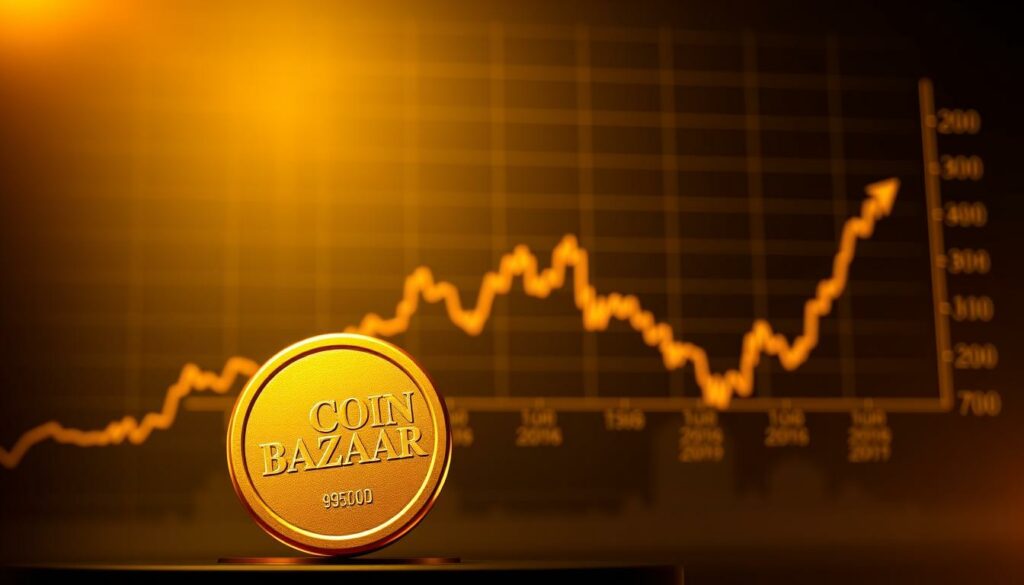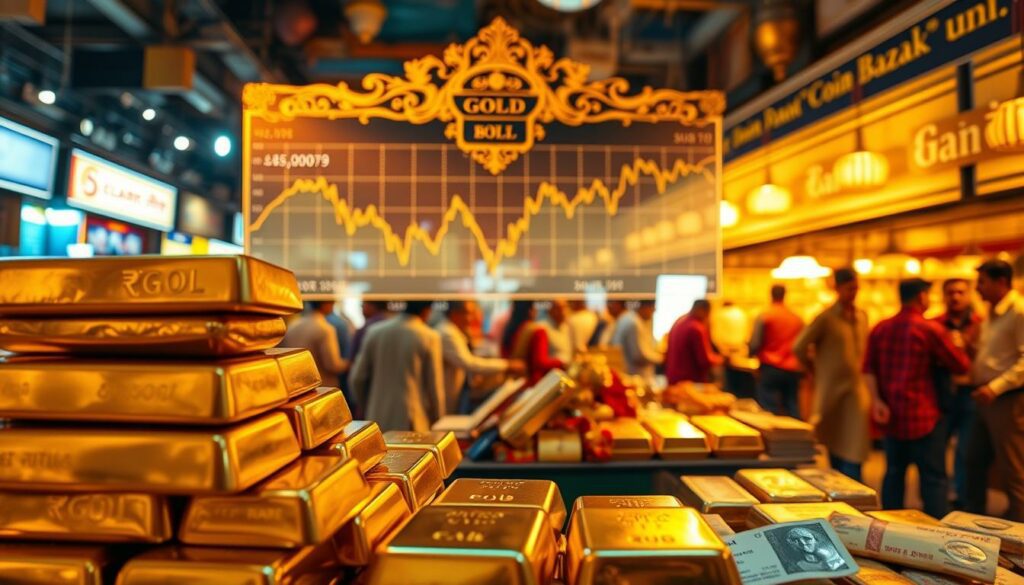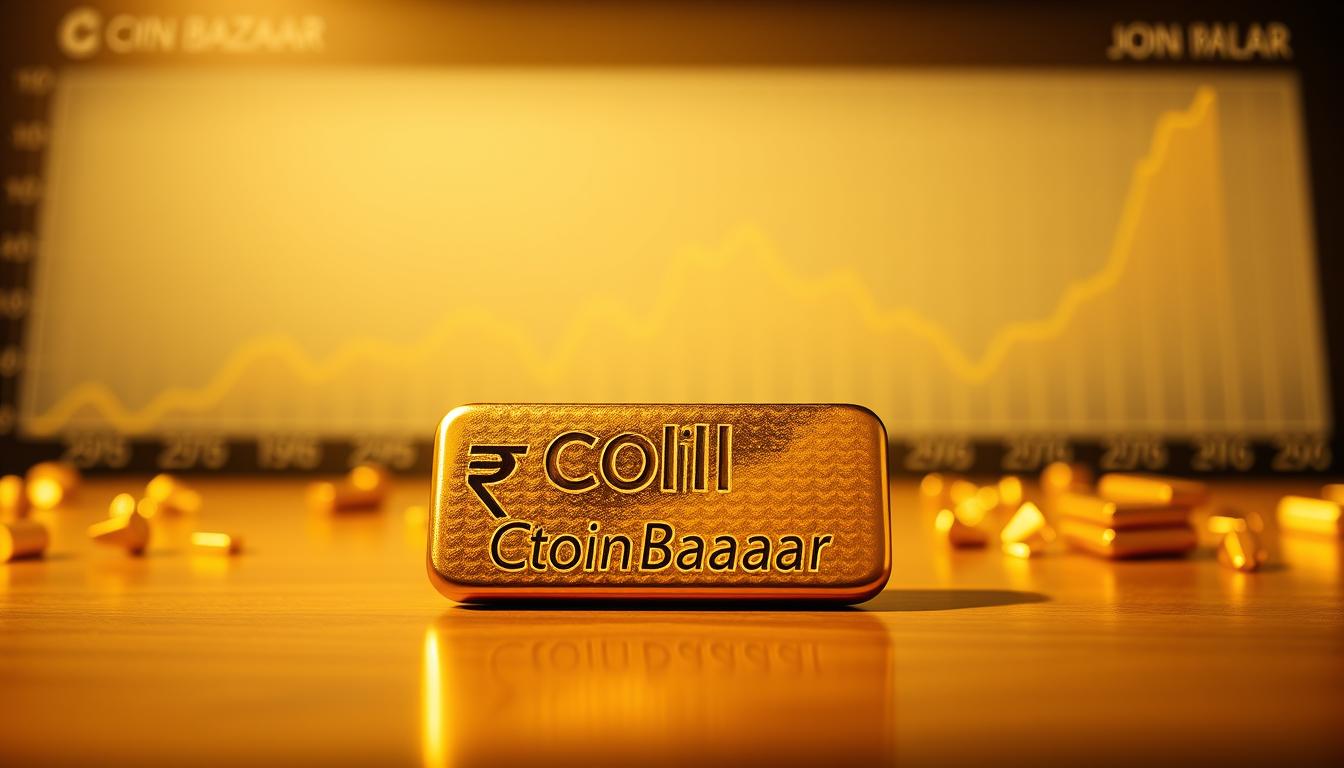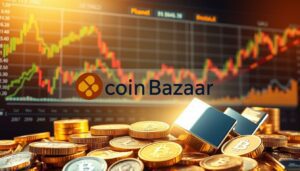Exclusive Deals & Trending Items


Divine Solitaires Diamond Earring for Women 18kt Gold Sol. Diamond 0.10 carats BIS Hallmark Certified
Shop NowThe value of gold has recently skyrocketed to ₹95,000 per 10 grams. This has left many investors wondering about the implications of this surge.
Curious about the factors driving this unprecedented rise? Global economic uncertainty and escalating US-China trade tensions have significantly contributed to the increase.
Furthermore, robust purchases by central banks have also played a crucial role in driving the gold price to new heights.
Key Takeaways
- The current gold price has reached ₹95,000 per 10 grams.
- Global economic uncertainty is a major driver of the surge.
- US-China trade tensions have contributed to the rise.
- Central bank purchases have been robust.
- Investors are advised to consider the implications of these factors.
The ₹95,000 Milestone: Analyzing the Recent Gold Price Surge
The gold price has jumped to ₹95,000 per 10 grams recently. You might wonder what’s behind this big jump. Several factors, like the prices of 24K and 22K gold, play a role. These are now at ₹95,170 and ₹87,190 per 10 grams, respectively.


Breaking Down the Price Components
The gold price includes base price, making charges, and taxes. Understanding these parts is key for smart investing. The base price is set by global markets, while making charges depend on the jeweler and jewelry type.
24K gold is purer than 22K, so it costs more. Knowing this helps when you buy gold.
Week-by-Week Price Movement to ₹95,000
Looking at the price over weeks, gold prices have gone up steadily. This trend is due to global economic issues like inflation and interest rates.
In recent weeks, prices have soared, with some weeks seeing over ₹1,000 increases per 10 grams. A gold price chart can show you these changes.
Current Gold Price Trends Across Indian Markets
Gold prices are rising, and it’s key to know the trends in India. The gold market in India shows different trends. Prices change a lot in different places.


Metropolitan vs. Tier-2 City Price Variations
Gold prices vary a lot between big cities and smaller towns. Metropolitan cities like Mumbai and Delhi have lower prices. This is because there’s more demand and better market flow.
In smaller towns, prices might be a bit higher. This is because there’s less market activity and higher costs to get the gold there.
24K vs. 22K Gold Price Differences
India loves both 24K and 22K gold, but they cost differently. 24K gold is purer and costs more. The price gap comes from the gold’s purity and the cost of making jewelry.
Knowing this helps investors make better choices.
Price Premiums in Different States
Gold prices also change in different states in India. This is because of local taxes and demand. Some states have higher prices because of taxes and more demand during festivals and weddings.
Investors should keep an eye on these changes to get the best deals.
Historical Context: Gold’s Journey to ₹95,000
Gold prices have hit ₹95,000 per 10 grams. It’s key to know what led to this point. Global economic worries and trade disputes have played big roles. Looking at the gold price history helps us understand today’s market.
Key Price Milestones in the Last 5 Years
In the last five years, gold prices have changed a lot. Let’s look at the major points:
- 2018: Gold price was around ₹30,000 per 10 grams.
- 2020: Prices jumped to ₹50,000 because of COVID-19.
- 2022: Gold hit ₹60,000 per 10 grams, thanks to world tensions.
- 2023: The price went up more, hitting ₹80,000.
- Current: Gold now is at ₹95,000 per 10 grams.
| Year | Gold Price (per 10 grams) |
|---|---|
| 2018 | ₹30,000 |
| 2020 | ₹50,000 |
| 2022 | ₹60,000 |
| 2023 | ₹80,000 |
| Current | ₹95,000 |
Comparison with Previous Price Rallies
Looking at the current rally with past ones shows us historical gold prices and trends. The jump to ₹95,000 is big. It’s due to ongoing global economic issues and trade disputes.
Knowing the historical context of gold prices helps investors. By studying past trends and comparing them to now, you can handle the gold market better.
Economic Factors Driving the Gold Price Rally
Gold prices have reached ₹95,000, and it’s key to know why. Several important factors are pushing up gold prices.
Global Inflation Concerns
Global inflation worries are driving gold prices up. Investors see gold as a safe-haven asset when inflation rises. This makes gold more valuable.
Supply chain issues and higher demand add to gold’s appeal. This is because of inflation.
Interest Rate Dynamics
Interest rates also affect gold prices. Low interest rates make gold more appealing to investors. This is because holding gold seems more worthwhile when interest rates are low.
But, when interest rates go up, bonds and other fixed-income assets become more attractive. This might reduce gold’s appeal.
Currency Depreciation Effects
Currency value changes also impact gold prices. A weaker currency means more money is needed to buy the same gold. This is especially true in India, where a falling rupee makes gold pricier.
| Economic Factor | Impact on Gold Price |
|---|---|
| Global Inflation Concerns | Increased demand for gold as a safe-haven asset |
| Interest Rate Dynamics | Low interest rates make gold more attractive |
| Currency Depreciation Effects | Weaker currency leads to higher gold prices |
Geopolitical Catalysts Behind Gold’s Price Movement
Gold prices have reached ₹95,000, thanks to geopolitical factors. As an investor, knowing these factors is key to making smart choices.
The rise in gold prices is not just about the economy. It’s also about global tensions that make markets uncertain. Geopolitical events often push investors towards gold, making it a safe choice.
International Conflicts and Market Uncertainty
International conflicts greatly affect gold prices. When tensions grow, investors look for safe assets. This demand boosts gold prices.
Trade Tensions and Their Impact on Gold
Trade tensions between big economies also influence gold prices. Policies like tariffs and trade wars can cause market ups and downs. This makes gold a popular choice for investors.
| Geopolitical Factor | Impact on Gold Price | Investor Behavior |
|---|---|---|
| International Conflicts | Increased demand for safe-haven assets | Investors buy gold, driving up prices |
| Trade Tensions | Market volatility increases | Investors seek safe-haven assets like gold |
It’s vital to understand these geopolitical factors for gold price analysis. By knowing what drives gold price changes, you can make better investment choices.
Gold’s Cultural and Economic Significance in India
Gold is more than just money in India. It’s deeply rooted in the country’s culture and economy. It plays a big role in Indian traditions, especially at weddings and festivals. This greatly affects how much gold people buy.
Wedding Season Demand Patterns
When it’s wedding season, gold demand goes up. It’s seen as key in wedding ceremonies. Families buy gold jewelry and coins as dowry gifts and to celebrate. This buying spree can push gold prices higher.
Festival-Related Gold Purchasing Behaviors
Festivals like Diwali and Akshaya Tritiya boost gold sales. People buy gold to wish for prosperity and luck. The high demand during these times can lead to more sales for jewelers. The belief that gold bought then brings luck drives this demand.
| Festival | Average Gold Demand Increase |
|---|---|
| Diwali | 20% |
| Akshaya Tritiya | 30% |
Knowing about these demand patterns can help you make smart gold investment choices. It’s important to consider gold’s cultural and economic role in India.
Gold vs. Alternative Investments in Today’s Market
Gold is now at a record ₹95,000 per 10 grams, making investors look at it and other options closely. It’s important to know how gold stacks up against other assets. This knowledge helps in making smart investment choices.
Gold vs. Indian Equity Markets
The Indian equity market has seen ups and downs, with some sectors growing a lot. Gold, however, has been steady. Equities might offer big gains but come with more risk. Gold is often seen as a safe place, protecting against market drops.
Think about how much risk you can handle when choosing between gold and equities. Gold is good for those who want stability and are cautious. But, if you’re okay with taking more risk for bigger gains, equities might be better.
Comparison with Fixed Deposits and Government Schemes
Fixed deposits and government schemes like the Public Provident Fund (PPF) and National Savings Certificate (NSC) offer safe, fixed returns. Gold, though, has given better long-term returns, even if its price can change. For example, gold has beaten many fixed-income options over the last decade, making it appealing for those looking to grow their money.
When looking at gold versus these other options, remember the current interest rates and inflation. Gold does well when inflation is high because it acts as a shield against rising costs.
Real Estate and Gold Investment Returns
Real estate is a favorite in India, offering income from rent and potential for value increase. But, it needs a lot of money and isn’t as easy to sell as gold. Gold has given strong returns compared to real estate, especially when the economy is shaky.
Thinking about adding gold to your portfolio? It’s a good choice because it’s easy to buy and sell. Plus, gold’s performance isn’t tied to real estate or stocks, making it a smart addition for diversification.
Building a Resilient Portfolio with Gold at ₹95,000
Investors are now focusing on creating robust portfolios as gold hits the ₹95,000 mark. With gold prices at an all-time high, it’s crucial to understand how to effectively incorporate this precious metal into your investment strategy.
Optimal Allocation Strategies by Age Group
The optimal allocation of gold in a portfolio varies significantly across different age groups. For younger investors, a smaller allocation towards gold (around 5-10%) might be suitable. This allows for more aggressive investment in other assets. In contrast, older investors may prefer a higher allocation (up to 20-30%) to gold. This is due to its safe-haven characteristics and potential for hedging against inflation.
| Age Group | Recommended Gold Allocation |
|---|---|
| 20-30 years | 5-10% |
| 30-50 years | 10-20% |
| 50+ years | 20-30% |
Rebalancing Techniques in a High-Price Environment
Rebalancing a portfolio when gold is at ₹95,000 involves periodically reviewing and adjusting your investments. This ensures they remain aligned with your financial goals. One effective technique is to sell a portion of your gold holdings when the price surges. Then, invest in other underperforming assets to maintain a balanced portfolio.
For instance, if your initial gold allocation was 20% and it has now increased to 25% due to the price surge, you might consider selling some gold. This would bring the allocation back to 20%. This strategy not only helps in managing risk but also in capitalizing on the high gold prices.
“Gold is often seen as a safe haven during economic uncertainty, making it a crucial component of a diversified investment portfolio.”
By adopting these strategies, investors can build a resilient portfolio. This portfolio leverages the benefits of gold at ₹95,000, while also managing associated risks.
Physical Gold Investment Options for Indian Buyers
Gold prices have hit ₹95,000 per 10 grams. Indian buyers are looking at different ways to invest in gold. Each option has its own benefits and things to think about.
Gold Coins and Bars: Pricing and Premiums
Gold coins and bars are a favorite among investors. Prices are based on the gold’s weight, plus extra for making and selling. It’s key to buy from trusted places to get real and good quality gold. The extra cost for coins and bars can vary, so it’s smart to compare prices.
Jewelry as an Investment: Pros and Cons
Jewelry is also a way to invest in gold. It’s pretty and can be worn, but it has higher making costs and resale problems. The making costs can raise the price a lot, and selling it might not be easy. Still, for those who like both beauty and investment, jewelry is a good choice.
Storage and Insurance Considerations
After buying physical gold, keeping it safe is very important. You can store it in home safes, bank lockers, or vaults. Insurance is also key to protect against theft, loss, or damage. The cost of keeping it safe and insured adds to the total cost of owning physical gold.
Knowing these points helps you make better choices for your gold investments.
Digital and Paper Gold Investment Avenues
The recent gold price rally to ₹95,000 has caught the eye of investors. They are now looking into digital and paper gold options. This shift is away from traditional physical gold.
Sovereign Gold Bonds: Features and Benefits
Sovereign Gold Bonds (SGBs) are a safe and government-backed choice. They are measured in grams of gold and come with an annual interest rate. This makes them appealing for those wanting regular income.
Gold ETFs and Mutual Funds in India
Gold ETFs and Mutual Funds let investors buy gold without needing to store it physically. These options track gold prices, making it easy to invest in gold’s movements.
Digital Gold Platforms: Comparison and Analysis
Digital gold platforms are gaining popularity for their ease and convenience. A look at these platforms shows differences in fees, storage, and how to get your gold back.
| Platform | Fees | Storage Options |
|---|---|---|
| Platform A | 0.5% | Allocated & Unallocated |
| Platform B | 0.3% | Allocated |
| Platform C | 0.2% | Unallocated |
Tax and Regulatory Aspects of Gold Investments
Gold prices are rising, making it key to know about taxes on your investments. With gold now at ₹95,000 per 10 grams, it’s vital to understand the tax and rules around gold in India.
Capital Gains Implications
Investing in gold, whether it’s physical or digital, has tax implications. When you sell gold, the profit is either long-term or short-term capital gains. Long-term gains, for gold held over three years, are taxed at 20% after adjusting for inflation. Short-term gains, for gold held for three years or less, are taxed based on your income tax bracket.
GST and Other Applicable Taxes
The Goods and Services Tax (GST) is charged on gold purchases at 3% without any cess. Also, making charges for jewelry are taxed at 5%. Knowing these taxes helps you figure out the total cost of your gold investment.
| Investment Type | Tax Implication |
|---|---|
| Physical Gold | 3% GST, Capital Gains Tax |
| Digital Gold | Capital Gains Tax |
| Gold ETFs | Capital Gains Tax |
Key Takeaway: Knowing the tax rules for your gold investments can help you make better choices and lower your taxes.
Expert Gold Price Forecast for Indian Markets
Gold prices have hit an all-time high. Experts are now sharing forecasts to help guide your investment choices. It’s key to understand the possible future price movements when investing in gold.
Experts have different views on the short-term trend. Some think there might be a slight drop, while others predict more growth.
Short-term Price Projections (2023-2024)
In the short term, gold prices are expected to be quite volatile. This is due to global economic signs and political tensions. A recent report suggests gold could hit ₹100,000 per 10 grams by 2024’s end.
“We expect gold prices to be supported by ongoing global uncertainties and inflation concerns,” said a leading economist.
Medium-term Outlook (2024-2026)
For the medium term, gold is seen as a safe asset. This could push prices up. Interest rates and currency changes will be key factors.
| Year | Predicted Price |
|---|---|
| 2024 | ₹100,000 |
| 2025 | ₹105,000 |
| 2026 | ₹110,000 |
Long-term Gold Price Predictions (Beyond 2026)
Looking ahead, gold is expected to keep growing in value. This is due to rising demand from new markets and its role against inflation.
When investing, it’s vital to think about these forecasts and how they match your financial aims.
Strategic Approaches to Gold Buying at ₹95,000
The rise in gold prices to ₹95,000 makes it crucial to explore new investment strategies. Two key methods are becoming more popular: systematic investment plans and buying gold during price dips.
Systematic Investment Plans for Gold
A systematic investment plan (SIP) for gold lets you invest a set amount regularly, no matter the price. This method helps spread out your investment costs over time, making it less affected by market ups and downs. By following a gold price chart, you can keep track of your investments and make smart choices.
For example, investing ₹5,000 every month in gold through an SIP can build wealth over time. Here’s a simple example:
| Month | Investment (₹) | Gold Price (₹/10g) | Units Accumulated |
|---|---|---|---|
| 1 | 5,000 | 95,000 | 0.0526 |
| 2 | 5,000 | 94,500 | 0.0529 |
| 3 | 5,000 | 95,500 | 0.0524 |
Timing Purchases Around Price Dips
Another strategy is to buy gold when prices are low. By watching the gold price chart, you can spot trends and potential price drops. This method needs patience and a good understanding of the market but can save you a lot of money.
For instance, if you see a regular drop in gold prices at certain times, plan your buys then. This smart timing can help you increase your gold holdings.
Common Pitfalls in Gold Investing at Record Prices
Gold prices are at an all-time high, and investors need to watch out for traps. The market demands a smart and informed approach to investing in gold.
Avoiding Emotional Decision-Making
Investing in gold at record prices can be tough. Avoid making impulsive decisions due to short-term market changes. Instead, keep your focus on your long-term goals and strategy. Knowing about gold price fluctuations helps you make better choices.
Authentication and Purity Verification Methods
It’s key to check if the gold is real and pure. When you buy physical gold, look for hallmarks or certifications from trusted assaying offices. Make sure to verify the gold’s purity and weight to dodge scams.
Hidden Costs to Watch For
Be mindful of the hidden costs of gold investing, like storage fees, insurance, and transaction charges. These costs can cut into your profits. It’s vital to include them in your investment plans.
| Hidden Cost | Description | Impact on Investment |
|---|---|---|
| Storage Fees | Costs associated with storing physical gold | Reduces overall returns |
| Insurance Premiums | Premiums paid to insure gold against loss or theft | Increases investment costs |
| Transaction Charges | Fees charged for buying or selling gold | Affects liquidity and returns |
Conclusion: Navigating India’s Gold Market in Uncertain Times
Gold prices have hit ₹95,000 per 10 grams. It’s key to understand gold price trends in India’s shaky market. Knowing what affects gold prices, like global economic issues and trade disputes, helps you make smart choices.
The rise in gold prices is due to economic and political factors. By studying these trends, you can plan your gold investments wisely. This includes physical gold, digital gold, or other gold-based financial products.
Knowing your options in India’s gold market is crucial. This includes gold coins, bars, jewelry, Sovereign Gold Bonds, and Gold ETFs. Each has its own pros and cons. Understanding these can help you create a strong investment portfolio.
By keeping up with gold price trends and adjusting your strategy, you can handle the ups and downs of India’s gold market.



















